Written by: Haseeb >|<
Compiled by: TechFlow
Is the market structure broken? Are VCs too greedy? Is this a rigged game targeting retail investors? Almost every theory I’ve seen on this seems wrong. But I’ll let the data speak for itself.
Here’s a widely circulated chart courtesy of @tradetheflow_ showing the recent underperformance of a bunch of coins listed on Binance. Most of these are derided as “high FDV, low float” tokens, meaning they have huge fully diluted valuations (FDV) but very little float on the first day.
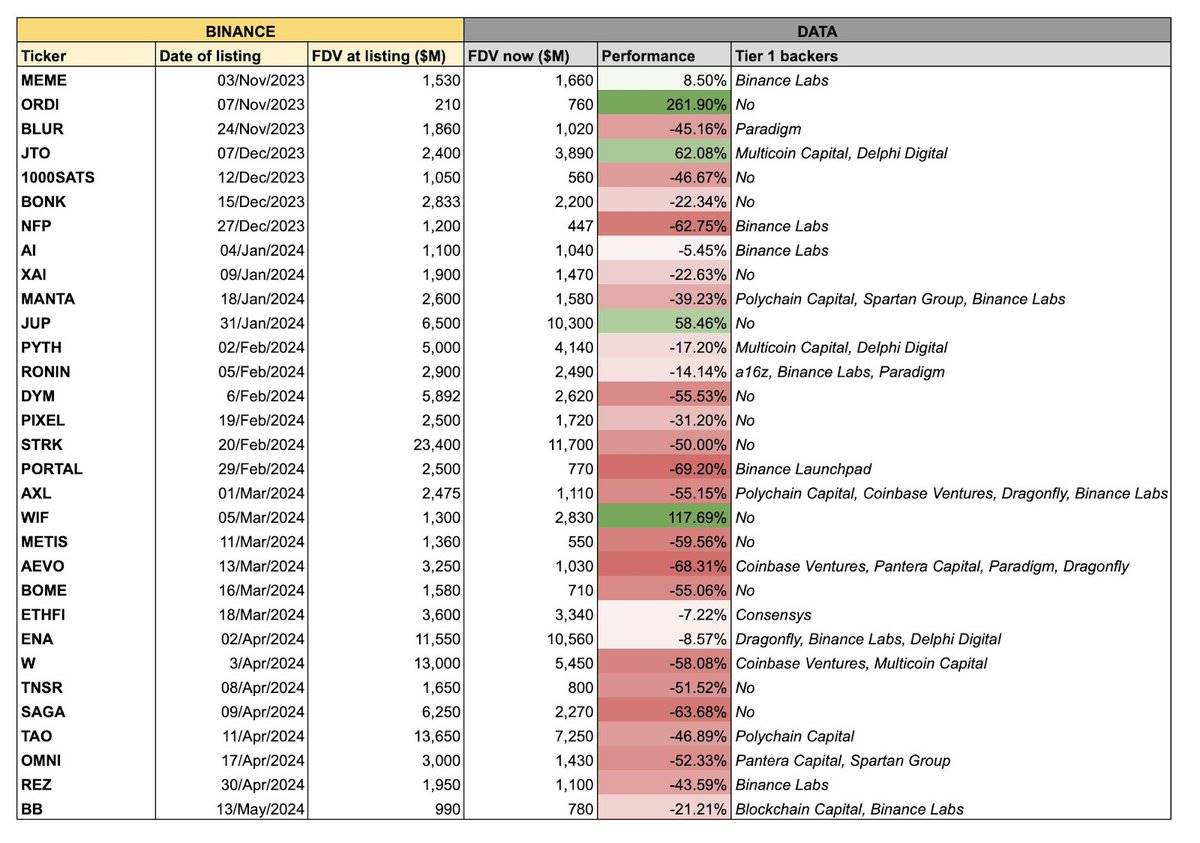
I plotted all of these charts and removed the labels. I excluded any obvious memes, and tokens that had a Token Generation Event (TGE) before Binance, like RON and AXL. Here’s what it looks like, with BTC (beta) in yellow:
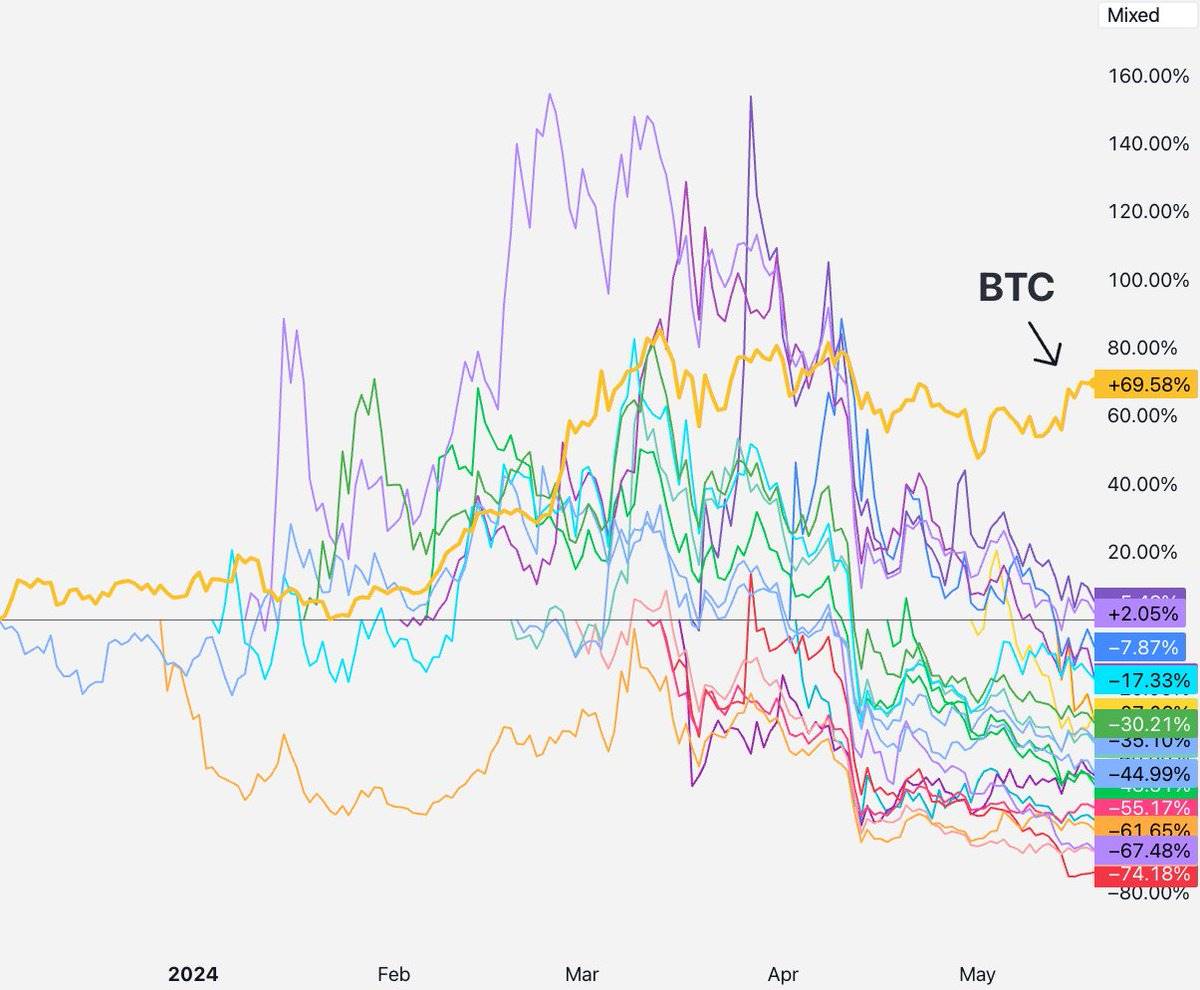
Almost all of these “low circulation, high FDN” Binance listings are down. What’s the reason? Everyone has a theory about what’s wrong with the market structure, and the three most popular ones are:
Venture Capitalists ( VCs )/Key Opinion Leaders (KOLs) Selling to Retail Investors
Retail investors are abandoning these tokens and buying memes instead
Supply is too low to allow meaningful value discovery
All of these are reasonable theories, let's see if they are correct. To do scientific research, we need a null hypothesis to test. In this case, our null hypothesis should be: these assets are all repriced, but there are no deeper market structure problems (the classic "more sellers than buyers"). We will discuss each theory one by one.
1) VC/KOL sells to retail investors
If this were true, what would it look like?
We should see tokens with shorter lock-up periods sell off faster than other tokens , while projects with longer lock-up periods or without KOLs should perform well. (Perpetual contracts may also be another avenue for this sell-off)
So what does the data show?
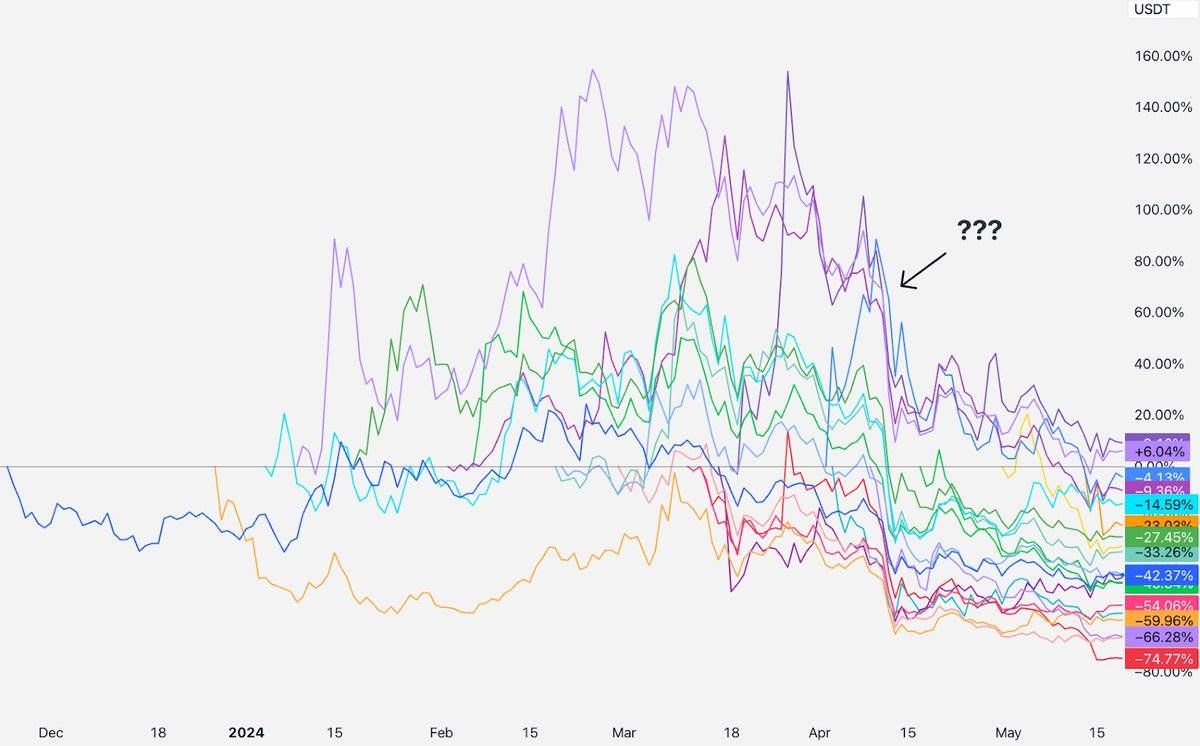
So from listing to early April, these tokens actually performed well, some were above the listing price, some were below the listing price, but most were concentrated around 0. Before that, it seemed that no VC or KOL started selling.
Then, in mid-April, all fell at the same time. Even though these projects were listed on different dates and had many different VCs and KOLs, could it be that all of these projects unlocked in mid-April and started selling to retail investors?
Let’s say I’m a VC. There are definitely some VCs that sell to retail investors. Some VCs don’t have lockups, they do hedging trades over the counter, and even violate lockups. But these are lower-tier VCs, and most of the teams that work with these VCs can’t get listed on a tier-one exchange. Every tier-one VC that comes to mind has at least a one-year waiting period and several years of lockup before they can get their tokens. For anyone regulated under Rule 144a under the SEC, the one-year waiting period is actually mandatory. And for large VCs like us, our positions are too large to do hedging trades over the counter, and we are generally contractually obligated not to do so.
So here’s why this story doesn’t make sense: All of these tokens are less than a year away from the token generation event, which means the VCs that had a one-year lockup are still locked up!
Maybe some of these lower-tier VC projects did sell tokens early on, but all projects fell , even the first-tier VC projects were in the lock-up period.
So investor/KOL selling may be true for some tokens - there will always be some projects with bad behavior. But if all tokens fall at the same time, this theory cannot explain this.
2) Retail investors are abandoning these tokens and buying memes instead
If this is true, we should see prices of these new tokens listed drop as retail investors turn to buying the meme.
However, what we see is:
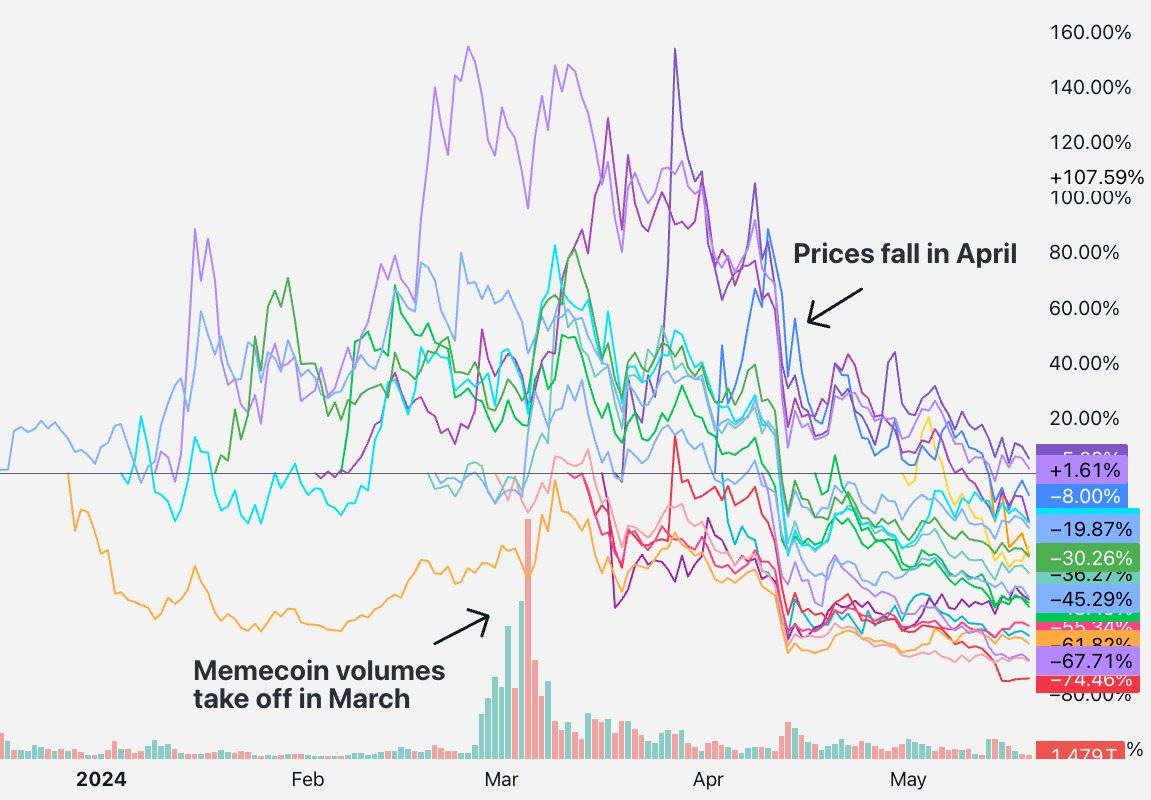
I compared the trading volume of SHIB tokens with those of these tokens, and the issuance time did not match. The meme craze reached its peak in March, but these tokens began to fall in April, a month and a half later.
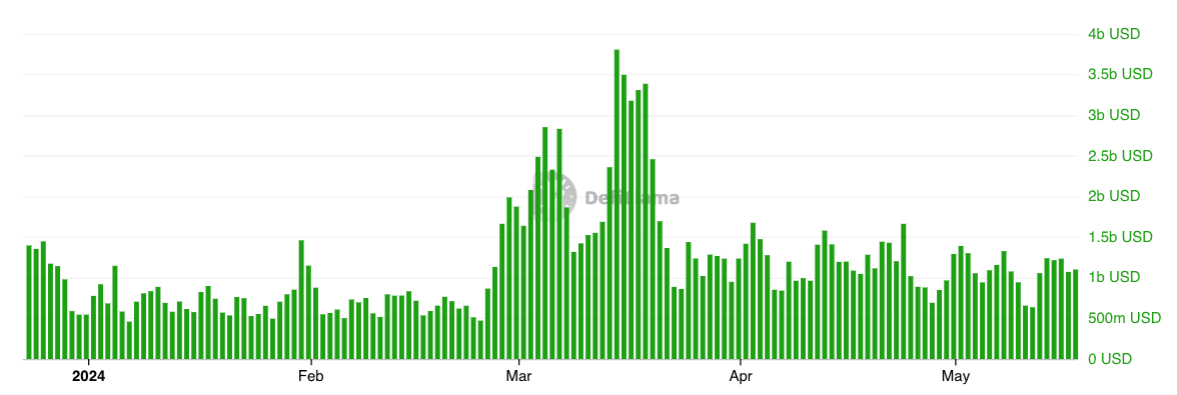
Here is the volume on the Solana DEX, and it tells the same story, the meme exploded in early March, well before mid-April. So that doesn't match the data either. There wasn't a broad influx of money into meme trading after these tokens dropped. People were trading memes, but they were also trading new tokens, and the volume wasn't conveying a clear message.
The problem is not the volume but the price of the asset.
That said, the story many are trying to promote is that retail investors are disillusioned with real projects and are now primarily interested in memes. I went to Binance's Coingecko page and looked at the top 50 most traded tokens, and about 14.3% of Binance's volume today is generated in memes . Meme trading is only a small part of the crypto space. Yes, financial nihilism is a thing and is very prominent on social media, but most people in the world still buy tokens because they believe in some technical story, whether it is right or wrong.
Well, maybe it wasn’t actually retail investors moving money out of VC tokens and into memes, but here’s a sub-theory: VCs owned too much of these projects, and that’s why retail investors left in anger. They realized (in mid-April?) that these were scam VC tokens, and the team + VCs owned ~30-50% of the token supply. That must have been the straw that broke the camel’s back.
It’s a satisfying story. But I’ve been investing in the crypto VC space for a while now. Here’s a snapshot of token distribution from 2017 to 2020:
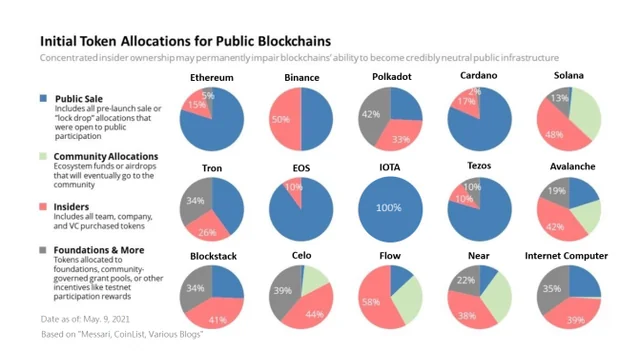
Look at the red shaded area - that's the share that insiders (team + investors) got. SOL 48%, AVAX 42%, BNB 50%, STX 41%, NEAR 38%, etc. It's pretty much the same today. So if the theory is "tokens weren't VC coins in the past, but are now", that doesn't match the data either. Regardless of the cycle, capital-intensive projects always have over-holding by teams and investors at launch. These "VC tokens" ultimately succeed, even after the tokens are fully unlocked.
In general - if what you are referring to also happened in the previous cycle, then it cannot explain the unique phenomena happening now.
So this “retail investors rage out and start trading memes” story rings true and is very compelling, but it doesn’t explain the data.
3) Supply is too small to allow value discovery
This is the most common theory I’ve seen. It sounds plausible! It’s not too dramatic, which is a plus. Binance Research even published a great report on the issue:
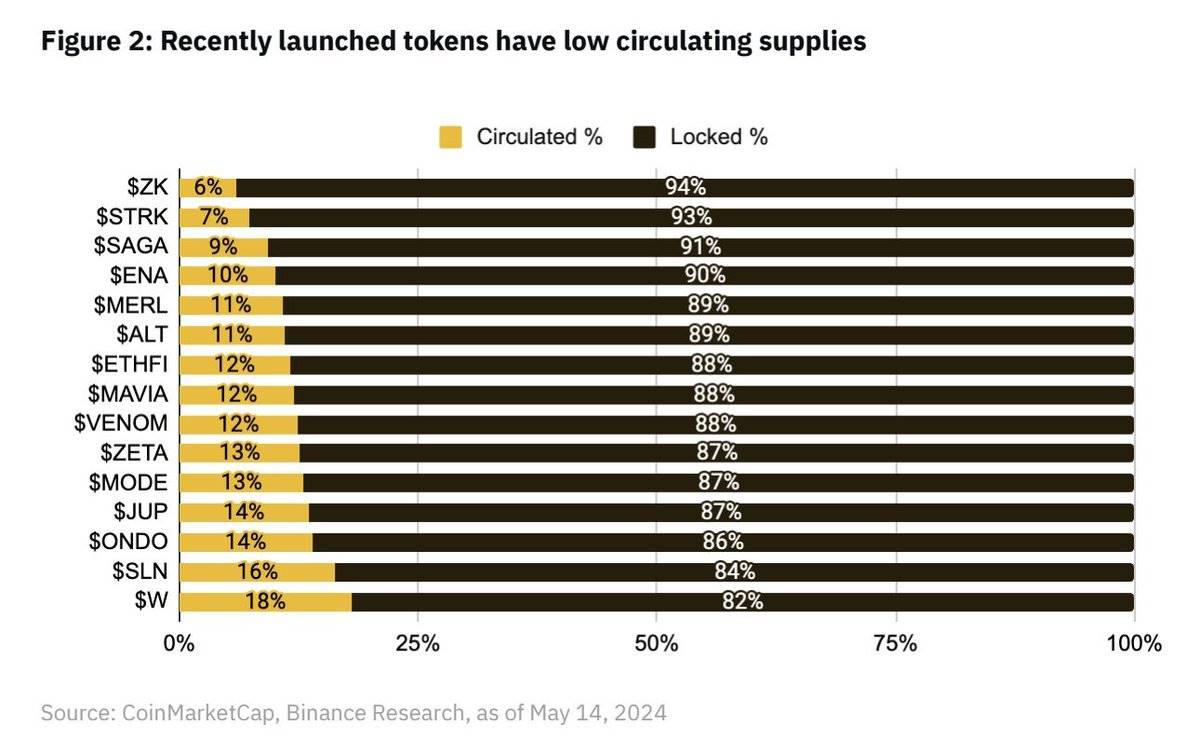
It looks like the average is about 13%. That's obviously very low, and obviously much lower than past tokens, right?
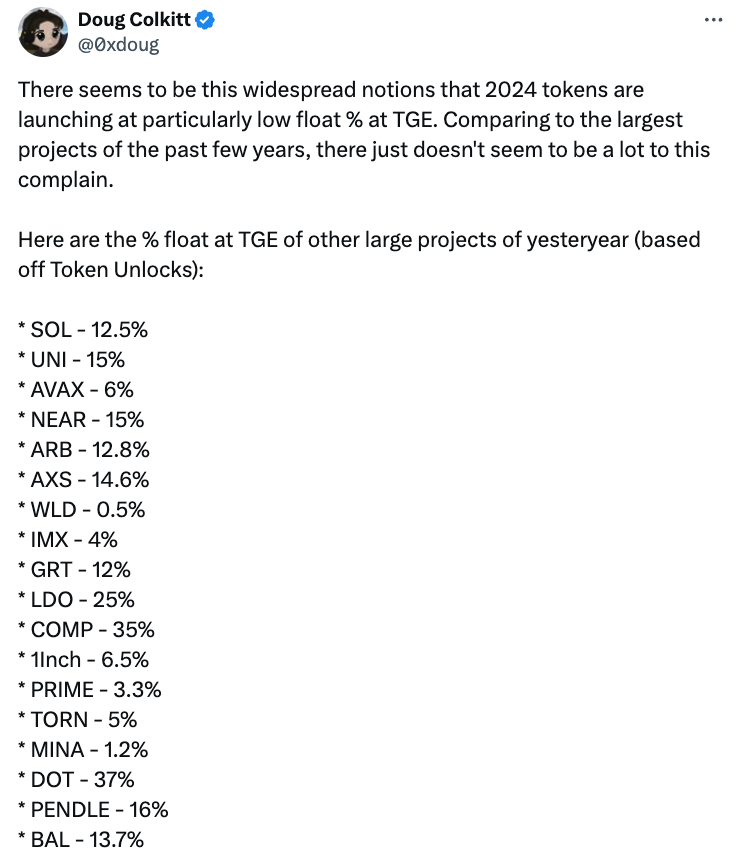
Thanks to @0xdoug for providing this data
The average circulation of these tokens at the time of generation in the last cycle was 13%.
The same Binance Research article also has a chart that has been widely circulated online, showing that tokens launched in 2022 have an average circulating supply of 41% at the time of listing.
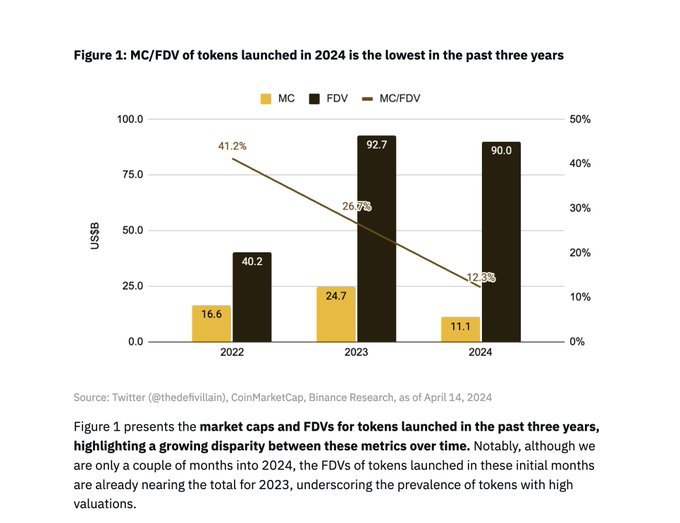
I was there in 2022 and the project did not launch with 41% of the circulating supply .
I checked the Binance list for 2022: OSMO, MAGIC, APT, GMX, STG, OP, LDO, MOB, NEXO, GAL, BSW, APE, KDA, GMT, ASTR, ALPINE, WOO, ANC, ACA, API3, LOKA, GLMR, ACH, IMX.
I checked a few of them at random since not all of them have data on TokenUnlocks: IMX, OP, and APE are similar to the latest batch of tokens we are comparing, with IMX having 10% of circulation on day one, APE having 27% of circulation on day one (but 10% of that is in the APE treasury, so I rounded it up to 17% of circulation), and OP having 5% of circulation on day one.
On the other hand, you have LDO (55% unlocked) and OSMO (46% unlocked), but those projects were listed a year before they were listed on Binance, so it's silly to compare those lists to the latest batch of listings. I guess these non-day one listings plus random enterprise tokens like NEXO or ALPINE are what's causing this crazy high number. I don't think they are determining a true trend in TGEs - they are determining a trend in what type of tokens Binance is listing each year.
OK, maybe you'll admit that 13% of circulating supply is similar to past cycles. But that's still not enough for value discovery, right? The stock market doesn't have that problem. The median circulating supply for IPOs in 2023 is 12.8%.
But seriously, having extremely low circulating supply is definitely a problem. WLD is a particularly bad example, with a circulating supply of only about 2%. FIL and ICP also had very low circulating supply at the time of listing, resulting in very bad price charts. However, most of this batch of Binance tokens are within the historically normal first-day circulation range.
Also, if this theory is correct, you should see the tokens with the lowest circulation being punished, while tokens with higher circulation should perform well, but we don’t see a strong correlation, they are all falling.
So this lack of value discovery argument sounds compelling, but after looking at the data, I’m not convinced.
solution
People keep complaining, but only a few come up with actual solutions! Before we discuss the null hypothesis, let’s examine them.
Many people suggest reintroducing ICOs. Sorry — don’t we all remember the brutal post-IPO sell-offs of ICOs that left retail investors burned? Also, ICOs are illegal almost everywhere, so I don’t think this is a serious suggestion.
@KyleSamani argues that investors and teams should unlock 100% immediately — which is impossible for US investors under 144a (and would also exacerbate the “VC sell-off” problem). Besides, I think we learned the benefits of team lock-up in 2017.
@arca thinks tokens should have underwriters like traditional IPOs . I mean, maybe? Token listings are more like direct listings, they are listed on exchanges and have some market makers, that's it. I think that's fine, but I prefer simple market structures and fewer middlemen.
@reganbozman suggests projects should list at a lower price so retail investors can buy in earlier and get some upside. I understand the spirit, but I don’t think it works. Artificially lowering the price below the market clearing price only means whoever catches the mispricing in the first minute of trading on Binance. We’ve seen this with many NFT mints and IDOs. Artificially undervaluing your listing only benefits the few traders who blow the order book in the first 10 minutes. If the market believes you’re worth X, in a free market you’ll be worth X by the end of the day.
Some people suggest we go back to fair launches . Fair launches sound good in theory, but don’t work well in practice because teams jump ship. Believe me, everyone tried this during the DeFi summer. What other non-meme fair launches have succeeded in the past few years besides Yearn?
Many people have suggested that teams do larger airdrops . I think that’s reasonable! We generally encourage teams to try to provide more supply on day one to improve decentralization and value discovery. That said, I think it’s unwise to do a ridiculously large airdrop just to boost circulation — protocols have a lot to do after day one to be successful. It’s unwise to release all of your token supply at once on launch day just to get a huge circulation, because you’ll have competition for token grants in the future. You don’t want to be one of those tokens that has to re-increase its token supply a few years later because the treasury has been drained.
So as a VC, what do we want to see happen here? We want to see token prices reflect reality in the first year. Our returns are not based on price appreciation, our returns are based on DPI, which means we have to liquidate our tokens eventually. We can't feed ourselves on paper appreciation, and we don't book unlocked tokens at market price (anyone who does this is crazy in my opinion). It's actually bad for VCs to have valuations reach astronomical numbers, but then plummet after unlocking. This will make LPs think that this asset class is fake, that it looks good on paper, but it's actually bad. We don't want that. We prefer asset prices to rise steadily over time, which is what most people want.
So are these high FDV estimates sustainable? I don’t know. This is obviously an eye-popping number compared to the prices at which projects like ETH, SOL, NEAR, and AVAX were initially launched. But it’s also true that cryptocurrencies are much bigger now, and the market potential for successful crypto protocols is clearly much greater than in the past.
@0xdoug Made a good point - if you normalize past altcoin token FDVs by today's ETH price, you get a number that's pretty much on par with the current FDVs we're seeing now . @Cobie also touched on this in his recent post. We're not going back to L1 with $40M FDV because everyone sees how big the market is now. But when SOL and AVAX launched, retail investors paid prices that were on par with ETH adjusted prices.
A lot of this frustration is actually due to the fact that cryptocurrencies have skyrocketed over the past five years. Startups are priced based on comparables, so all the numbers are going to be bigger. That's just the way it is.
OK, it's easy for me to criticize other people's solutions. But what is my clever solution?
I don't know either.
The free market will sort this out on its own. If the token goes down, then other tokens will be repriced, exchanges will push teams to list at a lower FDV, traders who got ripped off will simply buy the token at a lower price, and VCs will pass this information on to founders. The Series B round will be priced lower due to public market comparisons, which will annoy Series A investors and eventually seed investors, and price signals will always spread eventually.
When there is a true market failure, you may need some clever market intervention. But the free market knows how to fix mispricing — just by changing the price. Those who lost money, both VCs and retail investors, don’t need people like me to publish think pieces or debate on Twitter. They have learned their lesson and are willing to pay lower prices for these tokens. That’s why all of these tokens are trading at lower FDVs, and future token transactions will be priced accordingly.
This has happened before, it just takes a little time.
4) Null hypothesis
Now let’s demystify and see what happened in April that caused all the tokens to fall.
The culprit: the Middle East issue.
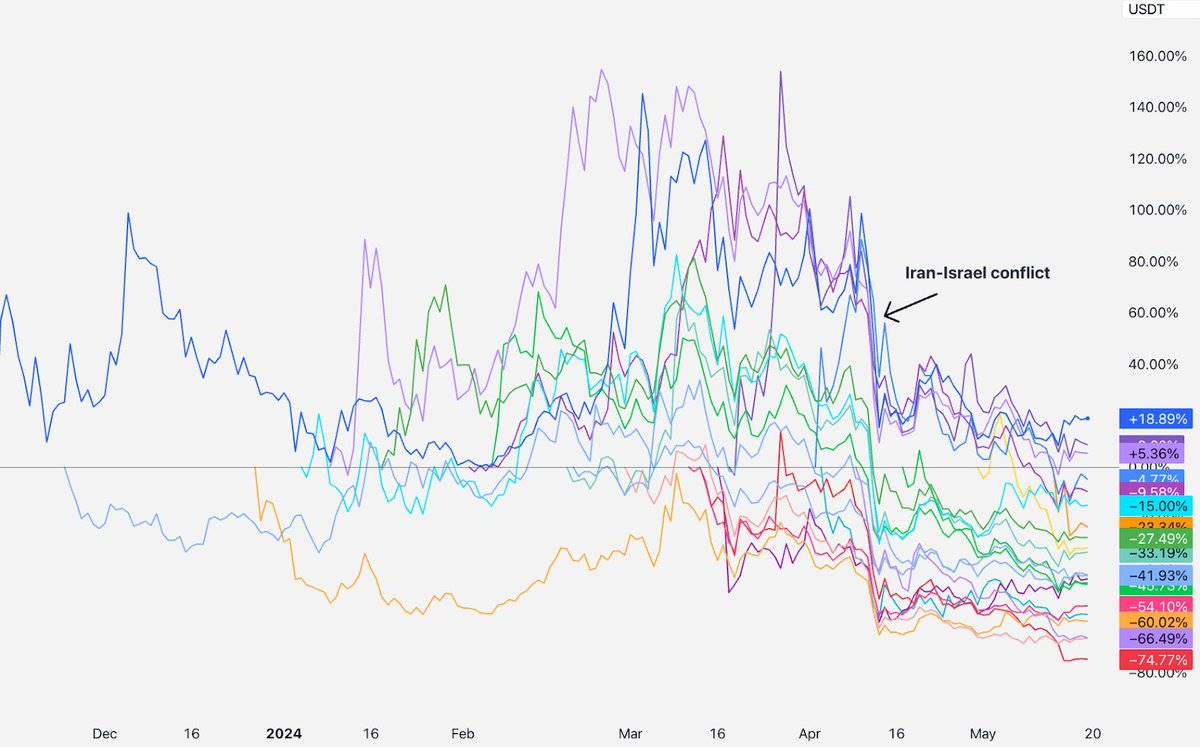
For the first few months, most of these tokens traded roughly flat after they were listed until mid-April. Suddenly, Iran and Israel started threatening World War III and the market tanked. Bitcoin rebounded, but these tokens did not.
So what is the best explanation for why these tokens are still falling? My explanation is: these new projects are all psychologically classified as “high-risk new tokens”. Interest in “high-risk new tokens” fell in April and has not recovered. The market does not want to buy them back.
Why? I don't know. Markets can be volatile at times. But if this basket of "risky new tokens" had gone up 50% during this period instead of down 50%, would you still be arguing about how token market structure was broken? That would also be a mispricing, just in the opposite direction.
Markets will eventually correct mispricing. If you want to help the market correct, then sell high and buy low. If the market is wrong, it will correct itself. No need to do anything else.
How should I do it?
When people lose money, everyone wants to know who to blame. Is it the founders? VCs? KOLs? Exchanges? Market makers? Traders? I think the best answer is no one. But thinking about market mispricing in terms of blame is not an effective framework. So I’m going to frame this from the perspective of what people can do better under the new market mechanism.
VCs: Listen to the market, slow down, and maintain price discipline. Encourage founders to be realistic about valuations. Don’t mark your locked tokens to market (almost all top VCs I know hold their locked tokens at a significant discount to market). If you find yourself thinking “there’s no way I’m going to lose money on this deal,” you’re likely going to regret the deal.
Exchanges: List tokens at lower prices. Consider pricing tokens via public auction on day one, rather than pricing based on what happened in the last VC round. Don’t list tokens unless everyone (including KOLs) has a market standard lockup period, and don’t even list tokens unless all investors/teams are contractually obligated not to hedge. Do a better job showing retail investors the FDV countdown chart we all know and love, and provide them with more knowledge about unlocks.
Team: Try to release more tokens on the first day, less than 10% of the token supply is too low.
Of course, do healthy airdrops and don’t worry too much about low valuations on day one. The best price chart to build a healthy community is a gradual increase.
If the team’s token goes down, don’t worry. You are not alone. Remember:
AVAX fell about 24% in the two months after its listing.
SOL fell about 35% in the two months after its listing.
NEAR fell by about 47% in the two months after its listing.
You'll be fine, focus on building something to be proud of and keep pushing forward, the market will eventually figure it out.
To you, Anonymous: Be careful of single-factor explanations. Markets are complex and sometimes they go down. Be suspicious of anyone who claims to know exactly why. Do your own research and don't invest anything you're not willing to lose.







